Diving in South Africa
Wikivoyage scuba diving region article
This article is intended to provide the already qualified scuba diver with information which will help to plan dives in the waters of South Africa, whether as a local resident or a visitor. Information is provided without prejudice, and is not guaranteed accurate or complete. Use it at your own risk. The information is primarily about recreational scuba dive sites, but may also be useful to the snorkeller or freediver.
If you are looking for information on getting training and certification as a recreational scuba diver, refer to the article on scuba diving for general information, or the regional article covering your area of interest, to find listings of dive schools.
More detailed regional information and listings of dive shops, operators, and other related services will also usually be found in the regional guides. Some information and listings for areas without a regional guide may be found in this article under the Services headings in the Destination section.
Understand
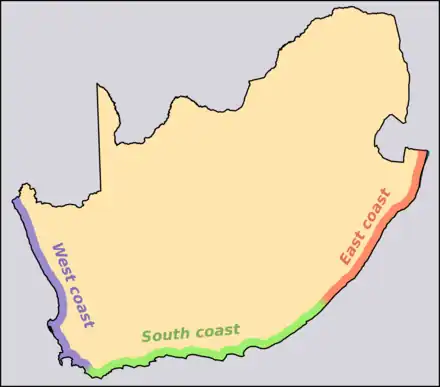
South Africa has sites spread along its coast that are perhaps better known for sharks and other large marine life, but also have a wide range of endemic smaller fish and invertebrates. The coastal sites range from tropical coral reefs in the north of KwaZulu-Natal on the east coast, where the fish are typical Indo-Pacific tropical species, and very colourful, through the warm temperate south coast with its rocky shores and many endemic species, to cool temperate rocky reefs on the west coast with their kelp forests, where the fish life is relatively dull, but the invertebrates provide the colour.
The annual sardine run from the south to the east coast is justly famous and the lesser known chokka (squid) spawning also attracts large numbers of predators, but without requiring as much chasing around to be at the right place. The right time is the problem there.
There are a large number of wrecks along the coast, some with historical importance dating back as far as the 15th century, and some of which are regarded as good dive sites. They tend to be concentrated near the harbours and near major headlands. The Cape Peninsula, Danger Point, Cape Agulhas, Algoa Bay and Durban have relatively large numbers of accessible wreck dives. The exact position of many wrecks is still unknown and finding them provides entertainment for some divers.
The inland sites are more usually used for training, technical and cave diving. They are freshwater altitude dive sites, some with a cave component, and range from shallow to very deep.
South African diving is generally more physically challenging than the more popular tropical destinations. It may involve cold water, surf launches, big swell or strong currents, depending on the region involved, and a higher level of fitness and skill is desirable if you want to enjoy the experience to the maximum.
The dive sites of South Africa can be grouped in four regions, each of which has generally similar water conditions, diving procedures, and biodiversity. These are the west coast, the south coast, the east coast, and the inland dive sites. The coastal diving regions approximate the coastal ecoregions more closely than the political regions, with some transitional areas, excepting that the west coast/south coast split is made east of False Bay, which is considered to be part of Cape Town's west coast diving neighbourhood.
For those who want more protected and benign conditions, there are two large aquariums where divers can enjoy warmer water and very easy access, and are guaranteed to see a large number of fish.
General topography
The physical geography of the region
.png.webp)
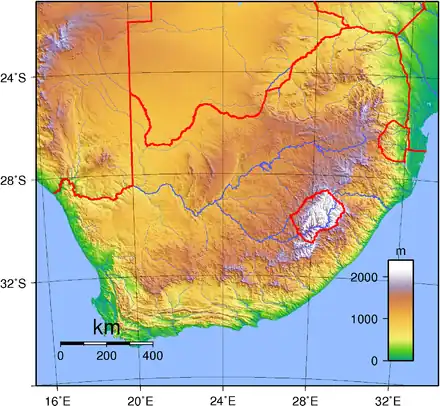
South Africa is the southern part of the continent of Africa, the only continent through which both tropics pass. The continent extends to a maximum of 34°50' of latitude south from the equator, and 37°20' North, so it is mostly tropical and subtropical, with a moderate extent of temperate zones. South Africa is the region of Africa furthest from the equator in the southern hemisphere. It extends from the Limpopo river in the north at S22°07' to Cape Agulhas in the south at S34°50', and from the Orange River mouth in the west at E016°27' to Ponta do Ouro in the east at E32°23'.
Oceans bordering South Africa
South Africa is one of the few countries with more than one ocean on its shores, and this has a profound effect on the sea conditions, not so much because the waters are nominally divided into two oceans, but because major currents of the two oceans have such profound differences and these strongly influence the adjacent ecosystems.
The coastline from the Orange River Mouth bordering Namibia in the north west to Ponto do Ouro bordering Mozambique in the north east is approximately 3750 km long, ranking 51st longest of 195 countries.
The width of the continental shelf off South Africa varies enormously, with a very narrow shelf off the north east coast of KwaZulu-Natal, and a wide shelf off the southern tip of Africa - The Agulhas Bank. The shelf narrows again off the Cape Peninsula, and is of moderate width from Cape Columbine north, along the West Coast.
The geographic division between the Atlantic and Indian Oceans is at the southern tip, Cape Agulhas, but from a practical point of view the sharpest distinction in qualitative terms is at Cape Point, and many Capetonians like to think of this being the place of Two Oceans. The reason for this is that the west coast is strongly influenced by the cold Benguela current, which flows north along the west coast, and the warm Agulhas current flows south on the east coast. The Agulhas current may be thought of as a continuation of the Mozambique current, which flows south west and then west as it follows the east coast. The Agulhas current is affected by the relatively shallow Agulhas Bank, and throws off some enormous eddies, some of which leak through into the South Atlantic, but most of which swing south and then east, and eventually dissipate in the southern ocean.
Climate, weather and sea conditions
West Coast
- Main topic: Diving the west coast of South Africa
In comparison with the tropical waters more familiar to many divers, the water is cold – it can be anywhere from about 20ºC down to 8ºC. It can be dark, and visibility can vary considerably – 8 m is considered fairly good, though it occasionally exceeds 20 m, and less than 3 m is considered bad. Locals generally consider 5 m to be the lower limit of acceptability. Significant bottom currents are rare but surface current can be sufficient to cause problems for divers who delay descent. Surge is common and can be tricky in a large and long period swell, which is not uncommon. There are sharks, including great whites, but they are seldom seen. Surface wind chop does not usually affect underwater conditions, but can make the boat ride or surface swim uncomfortable. The usual dive boat is a large RIB with two engines, launched from slipways, and carrying up to 12 divers, though boat access for the divers might be from a jetty. Shore entry diving is an option over much of the region depending on diver fitness and access to the water.
Technically the whole region is in the Atlantic Ocean – the official boundary with the Indian Ocean is at Cape Agulhas – but the ecological boundary between west and south coast is at Cape Point, and both local divers and marine biologists recognise a significant difference between the "Atlantic side" and False Bay.
South Coast
- Main topic: Diving the south coast of South Africa
From a diving perspective, the south coast can be considered to extend from about Danger Point at Gansbaai eastward to the far side of the Wild Coast. The region is dominated by the Agulhas Current, which flows south-west along the eastern part of this coast and is forced away from the coast by the widening continental shelf, allowing cooler water to push in along the shore, and breaking off enormous eddies. Rivers flow into the ocean along this coast and, as there is no strong inshore current to carry these waters away, their nutrient load is dispersed relatively gradually compared with the east coast. Many endemic species have evolved in this region. These are animals which are found nowhere else, and some of them have very limited ranges. For example, the Knysna seahorse is only found in three estuaries on the south coast. This region has higher sea surface temperatures than the west coast, reaching 22ºC in summer and averaging around 15ºC in winter. When dive conditions are good, there is a unique biodiversity to be explored in water that is not particularly cold.
East Coast
- Main topic: Diving the east coast of South Africa
The water of the east coast is warm with temperatures rising to up to 28ºC in summer and ranging between 18 and 24ºC in winter. Visibility is generally good, though many sites can be affected by river runoff in the summer rainy season. Current can be strong depending on how close the swift Agulhas Current pushes inshore, and surge depends on wave period and dive depth. The continental shelf of the east coast is narrow, and the shelf edge is shallow, so the Agulhas Current flows relatively close inshore. This narrow powerful current flows southwards down the east coast of Africa in a series of huge rotating gyres, bringing with it the cosmopolitan and varied Indo-Pacific tropical fauna in water heated by tropical sunshine, and limiting the northward spread of endemic species. Onshore winds blow over the warm water and bring rain to this coast in summer, and the runoff from the rivers carries silt into the sea. Where the continental shelf is very narrow, and the current flows close inshore, it rapidly replaces the silty water with clearer deep ocean water. The continental shelf extends further offshore near Durban, so summer visibility there is impaired, but further south at Aliwal Shoal and Protea Banks, the continental shelf is narrower again and therefore the water there is usually clearer.
Launches are from slipways, river mouths, or the beach, and beach launched boats normally return to shore by running up the beach behind a wave. Shore diving is an option at a few sites in Durban. Many sites are best suited to drift dives with a dive leader towing a marker buoy which the dive boat follows.
Marine ecology
South Africa's coastal waters can be divided into a number of biogeographical regions, though there is generally not a sharp distinction between them where the boundaries have been placed. There is more of a gradual change along the coast, from the tropical waters of northern KwaZulu-Natal to the cooler waters of the south coast.
The one place where there is a relatively distinct change over a short distance, is at Cape Point, where the waters of the east and west sides of the Cape Peninsula support noticeably different ecologies, and even here there is a significant overlap of resident organisms.
There are a large proportion of endemic species along this coastline, particularly along the South Coast.
The marine ecoregions
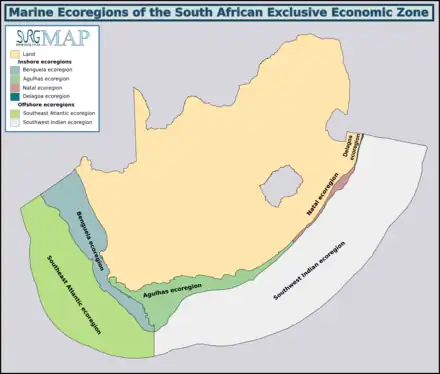
The regions of interest to recreational divers are the coastal ecoregions, which are accessible and shallow enough to dive. These are considered to extend from the shoreline to the break of the continental shelf, so most of the area is far too deep to dive.
- The cool temperate Benguela ecoregion extends from Sylvia Hill in Namibia to Cape Point. The cold Benguela Current is the major influence, and the region is characterized by large-scale intensive upwelling and nutrient rich water. At the south eastern end of this region, the break at Cape Point is very distinct in the inshore depth ranges, but in deeper areas it has been chosen as the depth contour at of 150 m, to approximately south of Cape Agulhas. This line is more consistent with the mixing zone of the Benguela and Agulhas currents, and is roughly parallel to the shelf edge.
- The warm temperate Agulhas ecoregion extends from Cape Point to the Mbashe River. The Mbashe River was chosen as the most appropriate boundary between the subtropical Natal province to the north, and the warm temperate Agulhas region to the south, but change is gradual between these regions. Upwelling on the south coast of South Africa is largely driven by the Agulhas current and the continental shelf. This form of upwelling forces cold deep water up onto the continental shelf, but not necessarily above the thermocline. In the region east of the Agulhas bank, wind enhanced upwelling, occurring mainly in summer, augments the current driven upwelling bringing the colder deeper waters to the surface. This enhances biological productivity by supply of nutrients to the euphotic zone (where plants have sufficient light to flourish) which fuels phytoplankton production, and rocky shores that are supplied with the nutrient rich water support rich algal biomass. The annual chokka (squid) spawning takes place largely in this region.
- The subtropical Natal ecoregion extends from the Mbashe River to Cape Vidal. This area has high riverine input, but the Agulhas Current is the major influence on the Natal ecoregion. Reef habitat is limited and the major reef areas include Aliwal Shoal and Protea Banks. The rocky reef communities are distinct from the coral reef communities further north as stony corals decline with increased turbidity to the south. The Natal ecoregion supports endemic soft corals. The annual sardine run is a feature of the southern portion of this region.
- The tropical Delagoa ecoregion extends from Cape Vidal northwards into Mozambique. A clear change in marine community structure at Cape Vidal is indicated by the intertidal habitat, seagrass and mangrove distribution patterns, and tropical seabird and cetacean species ranges.
Equipment
Ordinary recreational scuba diving equipment is sufficient for most dive sites in most of the regions. The largest variation in requirements being for exposure suits. In the tropical north-east, where water temperature is usually at or above 24°C, wet suits are worn as much for protection from the sun and stings as for warmth, while on the west coast a 7 mm wet-suit is barely sufficient, and dry suits are becoming more popular with divers who enjoy being comfortable at the end of a dive in water temperatures as low as 8°C. Most dive sites are relatively shallow — few are deeper than 40 m, and the majority are in the 10 to 30 m range.
Diver certification and legal liability
There is no legal requirement in South Africa for certification as a recreational diver. You are legally allowed to buy equipment and dive with it with no training, certification, experience or competence whatsoever. There is also no legal constraint preventing you from going to sea and jumping over the side of the boat of your own free will wearing only a weightbelt, but there are more comfortable and convenient ways to kill yourself.
Most, if not necessarily all, of the dive charter operators will insist that you are certified to dive to the depth and in the conditions expected at the dive site, or are accompanied by a certified instructor. This is not only because they are concerned for your safety, but also it cuts down on the paperwork if there is an accident. It is bad for business to have your clients die during an outing, so most operators are fairly diligent in ensuring that clients are informed of the probable conditions and site specific risks and the recommended level of certification. Waivers are required in most cases, and the diver assumes responsibility for his or her own actions, and unless there is strong evidence of negligence or illegal actions on the part of the operator, litigation after the event is unlikely to make the dependants wealthy.
Some operators will cancel a dive if the conditions look like they will be unpleasant, and probably all will cancel if the conditions look dangerous. However, this does not mean that the conditions will necessarily be safe for you if the dive is on. You are expected to judge for yourself what you can handle, and whether the situation will be within your capabilities on the day, and make your own decision. The crew can advise, but cannot think for you.
If you are a trainee on a certification programme, you have the right to expect the instructor to advise you on risk and safety, but unless you have no certification at all you are expected to be able to make a reasonable and responsible choice for yourself.
Destinations
Diving in South Africa occurs in three coastal regions, spread over three coastal provinces, and at inland sites, spread over a different set of provinces. The coastal destinations here are primarily listed counterclockwise round the coast and incidentally by province. Inland sites are just listed alphabetically as there is no obvious reason to do otherwise. The province makes no significant difference to the diver besides a general idea of where it is.
Western Cape
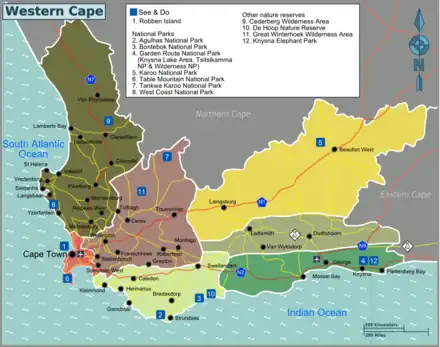
The Western Cape province is the most south western province in South Africa. It includes a large proportion of South Africa's tourist destinations and attractions, amongst which are several of the better known diving destinations.
Lambert's Bay
🌍 Lambert's Bay is a small fishing town of the west coast of the Western Cape 280 kilometres (170 mi) north of Cape Town. This is a stretch of coastline exposed to wind and seas with a westerly component. It is not generally considered a scuba diving destination, but is quite popular for freediving for kreef (west coast rock lobster) in season.
Elands Bay
🌍 Eland's Bay is a small fishing town in the Western Cape about 220 km (two and a half hours drive) north from Cape Town. It is not generally considered a scuba destination, but is fairly popular for freediving for rock lobster in season. It is a more a surfing destination and is also known for caves with rock paintings. It is not in an MPA, so no permit is required for scuba diving. Lobster diving requires a permit specifically for that activity and may not be done on scuba.
Paternoster
🌍 Paternoster is a small fishing town on the west coast of the Western Cape. It is not generally considered a scuba diving destination, but is quite popular for freediving for lobster in season, and has a few wreck sites worth diving after the day's catch has been landed if conditions are good. This is not a MPA, so a permit is not required for scuba diving, however rock lobster collection requires a permit.
Saldanha Bay
🌍 Saldanha Bay is a major port for ore export, and fishing harbour adjacent to several Marine Protected Areas and terrestrial nature reserves. It is not well known as a scuba diving destination, but there is a commercial diving school in the town and some recreational diving is also done nearby.
Dassen Island
🌍 Dassen Island is a small island nature reserve off the west coast of the Western Cape. It is not generally considered a diving destination as it is not easy to get there, but there are a few dive sites including some wrecks if you are in the area.
Silwerstroomstrand
🌍 Silwerstroomstrand is a beach to the far north of Cape Town. It is not generally considered a scuba destination, but there are a few sites.
Cape Town
- Main topic: Diving the Cape Peninsula and False Bay
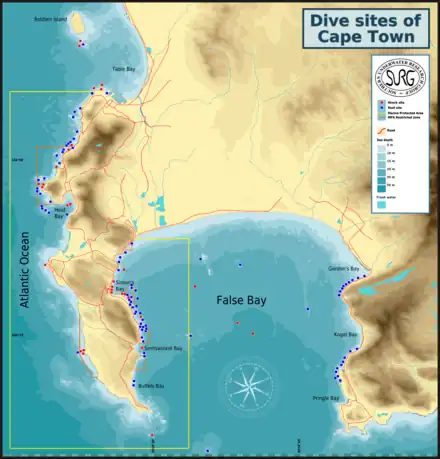
🌍 Cape Town is a major port city and the legislative capital of South Africa. The waters of Cape Town include the Atlantic seaboard, on the west of the Cape Peninsula which is cool to cold temperate, and False Bay, which is also cool temperate, but significantly influenced by the warmer waters brought down the east coast by the Mozambique current and the Agulhas current, and has some ecological similarity to the south coast.
Cape Point is accepted as the boundary between the cool temperate Benguela ecoregion of the west coast, and the warm temperate Agulhas ecoregion of the south coast. Unlike the other boundaries between the marine bioregions, which are diffuse, the ecosystems vary quite distinctively over a short distance at Cape Point, due to the change from the dominating influence of the warmer Agulhas current to the east to the cold Benguela current to the west.
There are many endemic species of fish, invertebrates and seaweeds, as well as a variety of other more widely distributed organisms, and a large number of shipwrecks, some of which are highly regarded as dive sites. False Bay is sometimes host to wandering fish from warmer regions, and occasionally even turtles, brought in on the currents from the east coast.
The mountainous Cape Peninsula, which separates the Atlantic Ocean from False Bay, also protects the coastal waters on each side from wind and waves from the other side, making it possible to have year round diving, but seasonal variations in where to dive and what to see, as there is a significant and noticeable difference between the ecosystems on the alternative shorelines.
There are three marine protected areas associated with the coastal waters of Cape Town: The Table Mountain National Park Marine Protected Area which includes most of the reef dives and a large number of the wrecks, the Robben Island Marine Protected Area, with mostly wrecks, but not so many and some quite deep, and the small Helderberg Marine Protected Area, with very few dive sites.
Betty's Bay
🌍 Betty's Bay is a small resort town in the Overberg district of the Western Cape. It was a popular freediving area for recreational abalone collecting before the fishery was closed to the public and became a major poaching problem.
Hawston
🌍 Hawston is a small resort and fishing town in the Overberg district of the Western Cape.
Hermanus
- Main topic: Diving in Hermanus
🌍 Hermanus is a small harbour town in the Overberg district of the Western Cape, well known for whale watching.
Gansbaai
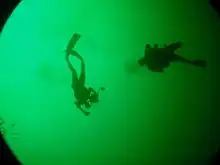
🌍 Gansbaai is a small harbour town in the Overberg district of the Western Cape, well known for cage diving with great white sharks, and the wreck of HMS Birkenhead.
Struisbaai
🌍 Struisbaai is a small fishing village in the Overberg district of the Western Cape. It is quite popular as a spearfishing destination.
Arniston (Waenhuiskrans)
🌍 Arniston is a small holiday town in the Overberg district of the Western Cape, named after its best known wreck.
Mossel Bay
🌍 Mossel Bay is a harbour town on the Garden Route in the Western Cape.
Knysna
🌍 Knysna is a harbour town on a large lagoon on the Garden Route in the Western Cape. Diving near the mouth of the lagoon is best done at high tide, as the currents can get very strong.
Plettenberg Bay
🌍 Plettenberg Bay is a holiday resort town on the Garden Route in the Western Cape, known mainly for its beaches.
Eastern Cape
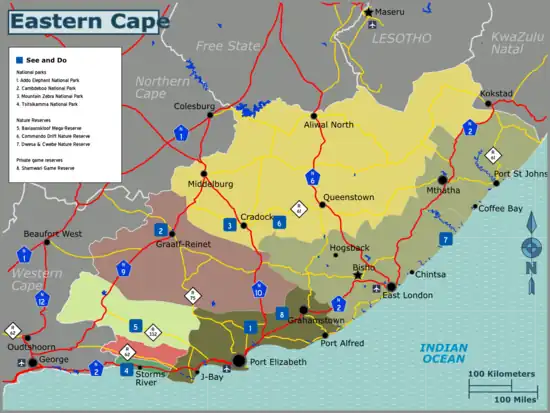
The Eastern Cape is a province on the south coast of South Africa on the coast of the eastern part of the Agulhas ecoregion, which is rich in endemic marine species. Diving is very dependent on weather conditions, and visibility is mot often good, but when it is good there is a lot to see. The water is generally warmer than the Western Cape, but there are occasional cold upwellings.
Tsitsikamma
- Main topic: Diving the Tsitsikamma
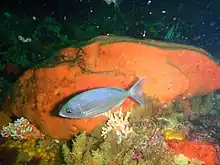
🌍 The Tsitsikamma National Park Marine Protected Area extends along the western part of the Eastern Cape coast and a small part of the Western Cape coast on the Garden Route.
Jeffrey's Bay
🌍 Jeffrey's Bay is a holiday resort town on the Eastern Cape best known as a surfing destination.
St Francis Bay
🌍 St Francis Bay is a small harbour town on in the Eastern Cape, known for the annual Chokka run.
Port Elizabeth
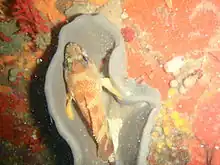
- Main topic: Diving in Port Elizabeth
🌍 Port Elizabeth is a major port city in the Eastern Cape on the shores of Algoa Bay, The dive sites are both inside the bay and to the west of Cape Recife, in and area known as the Wildside, which is more exposed to south-westerly swells, but is deeper and has more extensive reefs.
Port Alfred
🌍 Port Alfred is a small harbour town in the Eastern Cape at the mouth of the Kowie River.
SS Cariboo wreck
- Main topic: Diving in South Africa/SS Cariboo wreck
🌍 SS Cariboo wreck is the wreck of a passenger steamer about 3.4 km off the mouth of the Mgwalana river, northeast of Port Alfred.
Madacascar reef
Just to the north of the Bira river mouth, about 70 km north east of Port Alfred.
East London
🌍 East London is a port city in the Eastern Cape.
Wild Coast
🌍 The Wild Coast is the coastal region of the Eastern Cape from north of East London to the southern border of KwaZulu-Natal.
KwaZulu-Natal
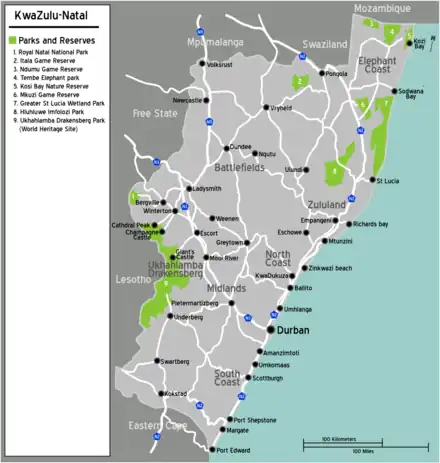
KwaZulu-Natal is a province on the east coast, between Mozambique to the north and the Eastern Cape to the south.
Margate
🌍 Margate is a small resort town on the south coast of KwaZulu-Natal near the Protea Banks.
Park Rynie
🌍 Park Rynie is a small resort town on the South Coast of KwaZulu-Natal.
Umkomaas and Scottburgh
- Main topic: Diving Aliwal Shoal
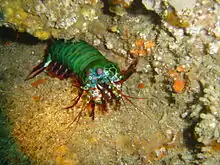
In 1849, after a ship, the Aliwal, nearly collided with an uncharted reef, its captain reported the position of this reef that later became known as the Aliwal Shoal. It is about 60 km south of Durban. The closest towns are 🌍 Umkomaas and 🌍 Scottburgh, both of which provide extensive tourist facilities, including for scuba divers.
The shoal is a fossilised sand dune lying roughly parallel to the coast, about 5 km from the shore. It comprises a narrow northern part, the crown, some 250 m wide, becoming about 800 m wide and finally with a wider landward ridge to the south, greater than 2 km in width. The crown varies in depth from about 6 m at the Northern Pinnacles to around 30 m on the seaward side. The mean depth of the crown area is 12.5 m. The southern wider area includes several protrusions that reach from a depth of some 30 m to around 15 m (e.g. Howard's Castle, Landers Reef). In the crown area, many dive sites, (e.g. Raggie Cave and Chunnel) have a large amount of uneven topography with small caves, ledges and swimthroughs rich in sea life, both in fish and invertebrates.
The shoal region has a subtropical climate with mean monthly air temperatures ranging from 17.0°C (Jul) to 23.9°C (Feb). The sea temperatures tend to be somewhat warmer, due to the warm, tropical, southward-flowing Agulhas current, resulting in 21-26°C throughout the year.
Durban
- Main topic: Diving in Durban
Diving in the major port city of 🌍 Durban in KwaZulu-Natal is affected by prevailing winds and the run-off from the Umgeni river, the Harbour mouth and the Umlaas Cutting on the Bluff which can affect visibility in the rainy season (spring: Sept – Dec) in the immediate vicinity of their mouths. The low seasonal rainfall and prevailing south westerlies which bring in clear water from the Mozanbique current make winter the best time to dive Durban (March through to July).
Ballito
🌍 Ballito is a coastal town on the North Coast (KwaZulu-Natal) of South Africa. It is mainly a resort town, featuring beaches and condominiums, but also has some dive sites.
St Lucia
- 🌍 Cape Vidal
Sodwana Bay
- Main topic: Diving Sodwana Bay
🌍 Sodwana Bay is one of the better known and more popular dive destinations in South Africa. It is in the far northeast of the country and is in the tropical Delagoa ecoregion with reef corals and typical Indo-Pacific marine life. Sodwana is inside the large iSimangaliso Marine Protected Area, and is famous for its coelacanths, which have occasionally been seen by technical divers at about 110 m depth in one of the shelf-edge canyons.
North Maputaland
Including 🌍 Mabibi and 🌍 Kosi Bay. These sites are also in the iSimangaliso Marine Protected Area.
Inland dive sites
- Main topic: Diving inland in South Africa
The inland dive sites are spread over a large area and include:
- 🌍 Badgat: — a flooded asbestos mine near Mbombela in Mpumalanga province.
- 🌍 Bass Lake: — A disused dolomite quarry near Meyerton south of Johannesburg in Gauteng province.
- 🌍 Boesmansgat: — A sinkhole, near Kuruman in the Northern Cape province.
- 🌍 Marico Oog: — a spring between Rustenburg, Zeerust and Lichtenburg, in North West Province
- 🌍 Miracle Waters: — a flooded chromium mine near Brits in the North West Province
- 🌍 Wondergat: — a dolomite sinkhole near Mafikeng in the North West Province
Itineraries
The annual sardine run is a notable event that moves along the south coast as the sardines migrate. Divers and other enthusiasts either follow the run along the coast or meet it as it passes major centres. Huge numbers of sardines are predated on by whales, sharks, dolphin, gamefish, seabirds and of course, humans.
Learn
There are recreational diver training schools at most diving destinations in South Africa. Affiliation is with a wide range of internationally recognised Recreational and Technical diving agencies, including PADI, CMAS-ISA, NAUI, IANTD, SSI, SDI/TDI and RAID. Certification from these agencies is generally accepted worldwide. The quality of training available depends more on the instructor and the school than the agency, as is the case in most parts of the world. South Africa has its share of quick turnover and never mind the standards, but also has some really good instructors. Read the standards and make sure you get what you pay for.
South Africa is also a destination of choice for Commercial diver training, as the certification is recognised by the International Diver Recognition Forum, and is much cheaper than in Europe.
Respect
Conservation and the poaching problem
There are concerns regarding the impact of sport diving on the reef ecology. Some of these may be legitimate, and study is necessary to test whether this is a real problem. The number of dives in the region has increased significantly over the years, but there is no reliable numerical data available. The number of sites has also increased, so the frequency of dives at most sites will not have increased proportionately.
Recreational divers are generally in favour of conservation, and as they are not permitted to collect or capture any marine life on Scuba in South African waters, generally do not consider themselves to make a significant environmental impact. There is evidence that some damage is done by contact with reef organisms and by disturbing the sediment. The question then, is how significant is this impact in comparison with other pressures?
The South African National Spatial Biodiversity Assessment 2004 Technical Report indicates that "Non-Extractive Recreational Activities" has been identified as a potential threat to marine biodiversity. This category is ranked 7th of the nine categories and includes Diver based activities such as snorkelling, scuba diving and cage diving to view sharks, as one of five subcategories. The identification and ranking of the potential threats was made by "Summed Expert Ratings", a procedure similar to the scoring method for competitive dancing, gymnastics and similar sports.
The authors claim that it has been established that scuba diving and associated activities can cause significant damage to coral communities by destructive contact (anchoring and diver damage), resuspension of sediments and by hand-to-coral contact. They also mention that coral reefs in South Africa are confined to the Greater St Lucia Wetland Park where anchoring or mooring is prohibited, and that current research has indicated that the coral reefs of this region have not experienced serious diver damage.
They also state that most divers cause very little damage to coral reefs although underwater photographers have been identified as a group that causes more damage to reefs than other users.
Their findings also show that the prevalence of predominantly soft corals on South African reefs makes them fairly resilient to diver damage.
Unfortunately the government department of Marine and Coastal Management has made use of this report and surveys on tropical coral reefs to support an effort to make money out of recreational diving on the reefs in all marine protected areas by imposing a permit system as a recreational diver tax. No surveys of temperate reefs can be produced to justify their claims that divers are a threat to the reef ecology, and it seems unlikely that their interference will benefit either the ecology or the diving industry.
At the time the policy was perceived as a thinly disguised attempt to tax what department political appointees appeared to see as a wealthy but politically powerless minority group. However, there was an immediate reaction by the recreational diving industry and the recreational divers who use the affected areas, to the effect that the proposed permit fees were reduced significantly and the industry is more united than it had ever been before. The non-profit organisation Underwater Africa was formed to represent the recreational divers and recreational diving industry and it has fought tirelessly for the rights of its constituency.
Even in its restricted scope the permit system may have damaged the industry, as a number of dive charter operators have subsequently gone out of business, and the main effect appears to be that divers are harassed by officials of MCM while poaching has increased.
There is no evidence that the permit system has achieved any of its stated aims of providing finance for improved conservation in the MPAs. It is questionable whether it even covers the cost of its own administration, and may be merely an employment opportunity for the otherwise unemployable.
Marine and Coastal Management has (2010) gone through a period of major change as the government split its responsibilities between two departments. Fisheries have been transferred to the Department of Agriculture Forestry and Fisheries (DAFF), and conservation has gone to Department of Environmental Affairs (DEA). Internal turf wars at upper levels appear to be continuing to reduce effectiveness, and the working staff seem to have difficulty getting their jobs done. The most notorious of the previous management appear to have been transferred sideways rather than fired. So it goes.
Marine Protected Areas
A large number of the most popular dive sites of South Africa are in proclaimed Marine Protected Areas, and a permit is required to scuba dive in any MPA. The permits are valid for a year and are available at some branches of the Post Office. Temporary permits, valid for a month, are usually available at dive shops or from dive boat operators who operate in MPAs. The permits are not expensive, but the requirement to have them present at the site is an annoyance, as they are paper, and the printing on them states that the original permit, the invoice, and the holder's original identity document or passport must be produced on demand.
The department has officially specified that notarised copies are acceptable, but this information does not appear to have been passed on to their staff, who are frequently reported as insisting on the originals, and their generally uncouth and threatening attitude is notorious. The same personnel are seldom available to take action when complaints of poaching are made. It is not clear whether this is because the poachers tend to react violently to interference, while recreational divers have a long history of non-violence, or because they are on the take.
There have been accusations of corruption against personnel of MCM, which have not been cleared up, and the fact that a large part of the department's income derives from marine products confiscated from poachers is seen by many to be a conflict of interests, as this income would dry up if poaching was stopped.
It should probably be mentioned that the policies of MCM regarding recreational diving restrictions are in many cases not supported by members of their research staff, though obviously these are private opinions.
As of 2010 MCM has been split between the Department of Agriculture, Forestry and Fisheries (DAFF) and the Department of Environmental Affairs (DEA). The situation has not improved after the split, and it is not clear, apparently even to the personnel of the two departments, who is responsible for what in the field of marine conservation. Some political officials appear to be attempting to gain short term popularity by trying to open reserves to artisanal fishers, in complete contradiction of the conservation policies, and enforcement is no better than before. Poaching goes on unabated, and divers are still harassed because it is much safer than attempting to apprehend the poachers, who tend to be armed and dangerous.
DAFF and DEA were recombined, with Agriculture split out, to form DEFF, the Department of the Environment, Forestry and Fisheries, which seems to be working a bit better. More MPAs have been proclaimed, mostly offshore in the Exclusive Economic Zone, but it is not clear if and how they are being protected.
Diving on wrecks
A lot of ships have been wrecked on South Africa's long, rugged and dangerous coastline during the last 500 years. Due to its strategic location on the historical trade route between Europe and the East, at least 2700 vessels are known to have sunk, grounded, been wrecked, abandoned or scuttled in South African waters.
Wrecks and their associated artifacts can be impressive and interesting sites for recreational scuba diving and underwater photography. The diversity of wrecks around the South African coast offers divers a wide range of sites to visit and explore. At the same time, historical wrecks are a unique, fragile and non-renewable cultural heritage resource of great archaeological value. We all have a responsibility to conserve this heritage for future generations.
Divers are free to visit most wreck sites, but should remember that they are privileged to have access to these sites, which are an important part of our collective cultural heritage.
The complex and delicate nature of wreck sites requires that divers are especially careful when visiting them. To preserve them for future generations to enjoy and learn from, it is important that you appreciate the importance of wrecks, dive responsibly and treat shipwrecks with care and respect.
Wrecks are also important habitats for marine life. Avoid damaging wrecks by carelessly touching them with your hands, knees or fins. The disturbance of protective coverings of sand, plant growth or the products of corrosion that have formed on wrecks can greatly increase the rate at which a wreck and its contents decay. This reduces the wreck's value as an historical resource and dive site and divers should avoid doing anything that will disturb the delicate equilibrium of a wreck site.
Anchoring into wrecks can cause severe damage to artifacts and the structure of the wreck. If you need to anchor, ensure that you do so well off the wreck. Remember that a wreck site is non-renewable, and won't regenerate like a damaged reef. Dive with care and leave the wreck as you found it.
Legal protection of wrecks
The wrecks of ships or aircraft, and any associated cargo, debris or artifact more than 60 years old and in South African waters are protected by the National Heritage Resources Act #25 of 1999 (NHRA). The law of salvage and finds does not apply to historical shipwrecks, which are considered by the NHRA to be archaeological material, and as such are the property of the state, administered by SAHRA in trust for the nation, and may not be disturbed in any way except under the terms of a permit issued by the South African Heritage Resources Agency (SAHRA).
There are severe penalties for contravening the Act, including heavy fines and jail terms. All members of the South African Police Services, and Customs and Excise officers may act as Heritage Inspectors in terms of the Act, with powers of search, confiscation and arrest.
Historical wrecks may be visited provided that the sites are not disturbed or interfered with and no artifacts are removed or damaged. Resist the temptation to take home souvenirs. Not only is it illegal to remove such material, but anything recovered from a wreck needs immediate conservation treatment or it will end up rotting away or disintegrating. Souvenir hunting strips sites of artifacts and the information they carry, and denies future divers the experience of diving on a well preserved wreck.
Take only photos, leave only bubbles!
Get help
- Emergency medical services vary in quality. Metro Rescue in Cape Town has a good reputation. However service will depend on availability of equipment and personnel. Hospital facilities also vary considerably, and most are understaffed.
- Recompression facilities are sparse. There are chambers in Cape Town, Durban and Pretoria. However, those which exist and are available, are competently manned and kept in good condition. Hyperbaric oxygen treatment is standard at these facilities.
- Divers Alert Network (DAN) has a branch in South Africa Their toll free line from within the country 0800 020 111, and regular line *27 (0)11 254 1112 will get you the 24-hour emergency hotline. If you are a DAN member and are involved in a diving accident, contact them first and they will make the necessary arrangements through whichever other organisations are most appropriate.
- National Sea Rescue Institute (NSRI) have stations near most places where seaside recreational activities are popular
- Underwater Africa "The CPR of diving: Conservation, Promotion and Representation”. Contact them if you have trouble getting a permit or are harassed by officials of MCM or other organisations. They may be able to help.
Stay safe
See also: South Africa#Stay safe
- Crime unfortunately is endemic to pretty much the whole country, but some parts are worse than others. Generally where there are more people there is more crime, but not always in direct proportion. South Africa has pretty good laws in general, but they do tend to protect the guilty more than the innocent, and as a result, enforcement often leaves a lot to be desired. Shortage of staff, indifference, and corruption within the enforcement bureaucracy also do not help.
- South African politicians have a reputation for corruption, generally not very competent corruption, but there appears to be a tendency towards greed, incompetence, nepotism and indifference towards the job. This tends to filter down though the bureaucracies. However, there are laws which are intended to deal with these problems, and blowing the whistle does not usually get the foreigner into trouble the way it can do in some other places. If you stand up to it they will often back off, failure to provide service is the most likely retaliation, and you can always go to the press. At this stage the press is free, though not always interested. The foreign traveller is often better off than the local inhabitant as they will get better publicity for complaints, and the official policy is to encourage tourism as it brings in money.
- Scuba diving permits are required by anyone who wishes to dive in a Marine Protected Area. These are available from some Post Offices in the vicinity of the MPAs, and are valid for all MPAs. They should be available over the counter for about R92. The Post Office does take credit cards though it is possible that some branches might not. You will be required to show your identity document or passport. The permit is on the same form as recreational fishing permits, and is not waterproof or water resistant, but you are expected to show it when requested by an inspector. A certified copy is authorised by Marine and Coastal management, the organisation issuing the permits, but this is contradicted by the text on the permit, and the enforcement officials appear to be unaware that the copy is acceptable. The documents have been reprinted and are being issued as of 2018. Carry the permit in your car, but don't bother to carry it on the boat, as no-one else will either.
- Pollution is a long-standing problem. Many municipalities do not provide adequate services, and in many places effluent is discharged in contravention of the law, by the authorities who should be preventing it. Industry can often arrange a blind eye to be turned when they discharge their wastes. A lot depends on who the major shareholders are and how much money is involved. Nevertheless, it is usually safe enough to dive along most of the coast. Specific regional problems will be detailed in the regional dive guides.
Hazardous marine organisms
These vary by region. Refer to the regional dive guide.
Breathing gas, safety and emergency equipment standards
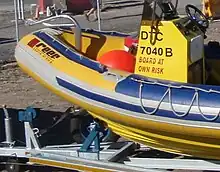

- Compressed breathing air quality from commercial suppliers is required by law to comply with SANS 10019. This is of an internationally acceptable standard. The filling station is obliged to keep a record of the results of air quality testing on site and show them to a user on request. This requirement is not usually stringently enforced, nevertheless, where there is competition for business, the air is usually good.
- Compressor Operators who fill cylinders are legally required to be competent in terms of South African National Standard SANS 10019, but there is no requirement for certification, and this requirement is not often enforced. The CMAS-ISA Compressor operator certificate is generally considered within the recreational diving industry to be a sufficient indication of competence, though not a necessary one.
- Compressed breathing gas fills are required by SANS 458:2005 table A.1(b) item 4 to be within 5% of the nominal fill pressure corrected to 20°C, and it is illegal to fill a cylinder to a higher pressure than a developed pressure equivalent to the working pressure stamped on the cylinder at 20°C, corrected to actual temperature when filled. The pressure must be checked before you leave the filling station, or it will be virtually impossible to prove deficiency. All filling stations are required to provide an accurate and calibrated pressure gauge if requested. In practice the gauges are seldom recently calibrated.
- Scuba cylinder colour coding is prescribed by SANS 10019 to be canary yellow with a french grey shoulder. Nitrox and trimix cylinders should have been cleaned for oxygen service before first use with mixed gases, and be labeled for the service. Technically a commercial filling station may not fill a cylinder that is not the right colour or is not in date for visual inspection and hydrostatic tests. Privately owned, filled and used cylinders are not restricted in the same way.
- Nitrox fills will normally be mixed on demand, and the customer is expected to personally test or observe the test for oxygen content and sign for it. After that it is your own business what you do with it. You may be asked to show Nitrox certification, but that is up to the seller, and is not required by law. Cylinders to be filled with Nitrox are required by law to have a label showing the composition of the contents, but the specifications for the label are so mind bogglingly incompetent that filling stations may require more rationally useful labels than legally required. Most stations will accept cylinders with the old style labels, as they at least provide adequate information. Composition is usually written on masking tape with a waterproof marker and stuck to the shoulder of the cylinder. This may or may not be legal, as the authorised experts are not keen to admit either way, and it is the standard procedure.
- Cylinders to be filled with Trimix are also required to be labelled with the contents. The size and position of the label is specified, but it is not required to actually be visible, and it is a position commonly covered by tank bands if the cylinders are twinned. Additional labels which can actually be seen are not forbidden, and may be used.
- Cylinders dedicated to 100% oxygen for breathing must be black with a white shoulder, but Nitrox cylinders may be filled with 99% Oxygen, and Nitrox mixes only need to be analysed to the nearest 1% accuracy. If you have a Nitrox cylinder filled with Oxygen for decompression gas, label it as 99% and it will be legal.
- Medical oxygen specifically intended for surface first aid purposes should be carried in the official black cylinder with white shoulder. Most have a pin index valve, but this is not a legal requirement, and a bullnose fitting as is used on bulk cylinders, or a scuba pillar valve may also be used, depending on the regulator available. As it is not a legal requirement to carry medical oxygen on a dive boat, it is also not a requirement to use any specific type of regulator. The regulators marketed by DAN are popular, and possibly the best for purpose, as they allow 100% on demand for conscious users and can also supply free-flow to a medical mask for unconscious users. Other types may be diving regulators which will only supply a demand regulator, and some older free-flow systems intended for general first aid purposes.
- The law requires that cylinders which are to be filled with gas mixtures containing more than 23% oxygen must be cleaned before the first fill with such gas mixture. Filling stations often require that there is an Oxygen clean label on the cylinder if it is to be filled by partial pressure blending, but this is not a legal requirement.
- Oxygen is carried by most dive charter boats, and this is considered the industry standard, though not required by law.
- First aid kits are required by law to be carried on boats.
- Skippers of dive boats are required by law to be certified for the category of vessel they operate, and to have a diving endorsement to the certificate. This certificate must be carried on the boat, so you can expect to be shown it if you ask at a reasonable time. If the boat is launched through the surf, the skipper's certificate must also be endorsed for surf launching. Unfortunately the certificate does not guarantee competence, but most of the skippers get good or get out.
- Skippers are also required to be trained in basic first aid, but this is very basic and does not include decompression illness.
- Dive boats are obliged by law to carry safety equipment and pass a safety inspection every year. This is shown by a certificate and a decal on the boat.
- Vessels used for any commercial purpose must be licensed or registered in terms of the Merchant Shipping Act.
- Small craft licensing: You can recognise and identify a licensed vessel by the license number it must display on the sides. The number consists of a prefix identifying the licensing authority, followed by a number identifying the vessel, and any applicable category letters.
- South African Maritime Safety Authority (SAMSA) uses DT plus a letter identifying the port of origin. DTC is Cape Town. The number may be followed by a class letter indicating the waters the boat is licensed and equipped to operate in.
- South African Deep Sea Angling Association (SADSAA) uses club identification prefixes.
- South African Sailing (SAS) uses SA for sailing vessels and ZA for motor vessels
- South African Small Craft Association (SASCA) uses U followed by the category and then the number.
- South African Institute for Skippers (SAIS) uses A
- South African Police Service (SAPS) uses SAPS
- Small craft licensing: You can recognise and identify a licensed vessel by the license number it must display on the sides. The number consists of a prefix identifying the licensing authority, followed by a number identifying the vessel, and any applicable category letters.
Stay healthy
- Malaria is endemic to some regions in the north east of the country. For divers this is mainly northern KwaZulu-Natal.
- Bilharzia is also endemic to some regions on the east coast, but only affects fresh water, so is not generally a problem to divers.
- HIV is widespread. However it is not really a particular problem for recreational divers.
Work
A recreational diving certification does not qualify you to work as a diver except as recreational divemaster or instructor. All other underwater work done for reward or as part of your employment requires registration as a commercial diver, or a recognised foreign equivalent. This includes scientific diving, including for your own postgraduate research at most universities, and at all research institutions.
The recreational diving industry is specifically excluded from the scope of the South African Department of Employment and Labour's Diving Regulations, but not from the rest of the Occupational Health and Safety Act and its other relevant regulations.
Citizen science data collection, whether entirely autonomous, or as part of an organised project, is not considered to be within the scope of the diving regulations, provided that each diver is personally responsible for the planning and execution of all their dives, and not under the direction of any other person regarding the safety of the dive.
Learn
Recreational diver training
All major diving centres in South Africa have recreational diver training schools. Most of the major international diver certification agencies are represented in South Africa. See also the regional dive guides for local details.
These include:
- PADI
- NAUI
- CMAS
- SSI
- IANTD
- TDI/SDI
- RAID
Technical diver training
Technical diver training is available at the major centres such as Cape Town, Durban and Johannesburg, and at Badgat, also marketed as Komati Springs, where the site is suitable for deep and cave diving throughout the year. Rebreather training is available, but only where there is an instructor certified to train the specific equipment. This varies from time to time.
Commercial diver training

(Including scientific diving and public safety diving)
The South African Department of Employment and Labour certifications in Commercial Diving are recognised by the International Diver Recognition and Certification Forum. Divers holding certification that is recognised by the IDRCF may legally work as commercial divers in countries represented on the forum, provided that other visa and work permit conditions are complied with.
There is not a great deal of commercial diving work in South Africa, and the pay is not very good by world standards, but the training is cheaper than in most other countries on the IDRCF, and as a result South Africa has become a training destination for foreign commercial divers. Learner divers from Europe have commented that the cost of training at home covers the training costs, medical examination, travel and living expenses and enough change for an additional vacation in South Africa. South African commercial diver training is also popular with learner divers from many countries where there is no officially sanctioned commercial diver training system, and the certification, though there is no guarantee of employment, allows the holder to apply for lucrative work in the international offshore petrochemical industry.
A reasonable ability to communicate in English is a prerequisite, and medical fitness to dive must be verified by a medical practitioner registered as a Diving Medical Practitioner with the South African Department of Employment and Labour. Foreign medical certificates of fitness to dive are not recognised for commercial diving.
Read
- Branch, G. and Branch, M. 1981, The Living Shores of Southern Africa, Struik, Cape Town. ISBN 0-86977-1159
- Branch, G.M. Griffiths,C.L. Mranch, M.L and Beckley, L.E. Revised edition 2010, Two Oceans – A guide to the marine Life of Southern Africa, David Philip, Cape Town. ISBN 978 1 77007 772 0
- Gosliner, T. 1987. Nudibranchs of Southern Arica, Sea Challengers & Jeff Hamann, Monterey. ISBN 0930118138
- Heemstra, P. and Heemstra E. 2004, Coastal Fishes of Southern Africa, NISC/SAIAB, Grahamstown.
- Ed. Smith, M.M. and Heemstra, P. 2003 Smith’s Sea Fishes. Struik, Cape Town. (Authoritative, large and expensive)
Regional references
West Coast
- Stegenga, H. Bolton, J.J. and Anderson, R.J. 1997, Seaweeds of the South African West Coast. Bolus Herbarium, Cape Town. ISBN 079921793X (rather technical)
Cape Town and the Cape Peninsula and environs
KwaZulu-Natal
- De Clerck, O. Bolton, J.J. Anderson, R.J. and Coppejans, E. 2005,Guide to the seaweeds of KwaZulu-Natal Scripta Botanica Belgica; vol 33, National Botanic Gardens, Meise, Belgium. ISBN 9072619641
- King, D. 1996 Reef Fishes and Corals: East coast of Southern Africa. Struik, Cape Town. ISBN 1868259811
- King, D. and Fraser, V. 2002, More Reef Fishes and Nudibranchs, Struik, Cape Town, ISBN 186872686X